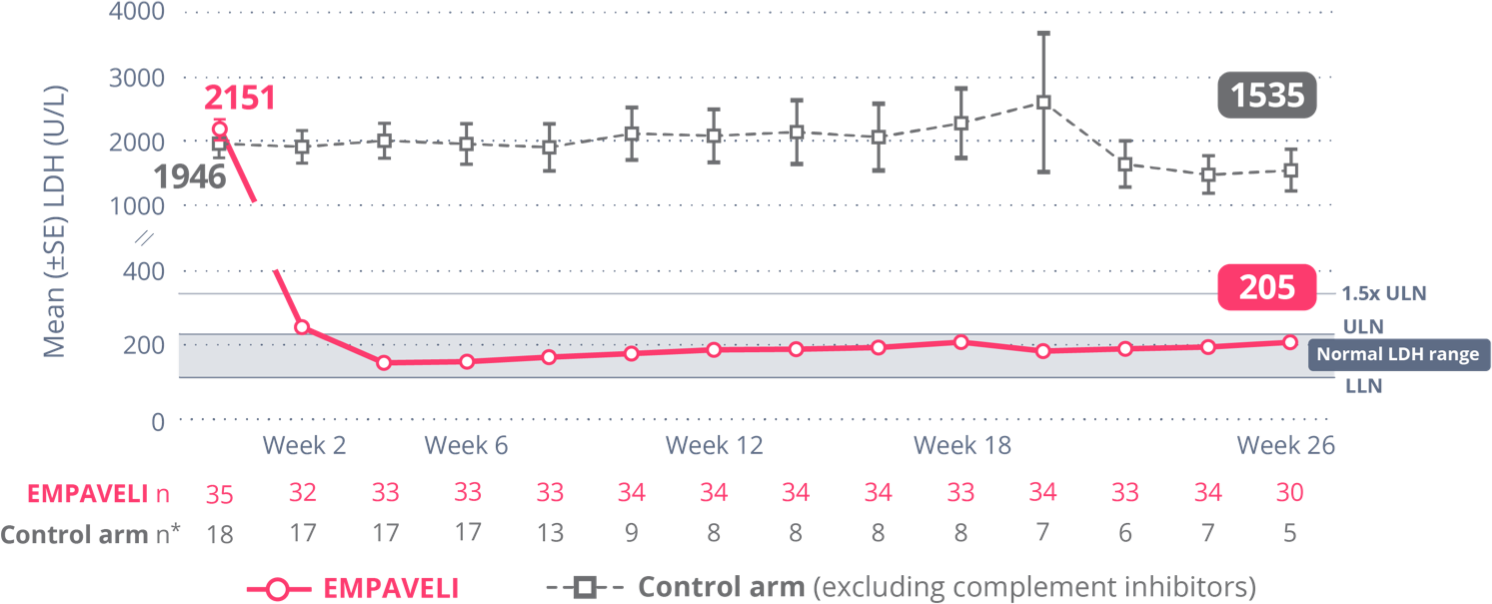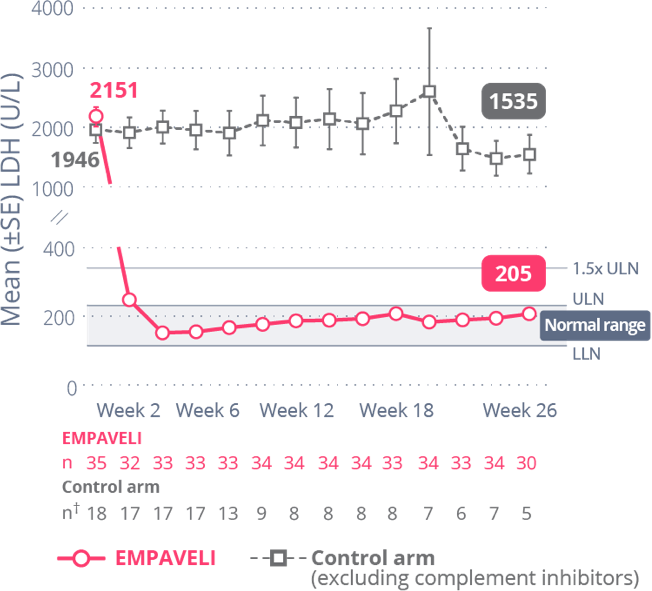EMPAVELI demonstrated efficacy across
key measures of PNH disease activity1
IMPORTANT SAFETY INFORMATION
WARNING: SERIOUS INFECTIONS CAUSED BY ENCAPSULATED BACTERIA
EMPAVELI, a complement inhibitor, increases the risk of serious infections, especially those caused by encapsulated bacteria, such as Streptococcus pneumoniae, Neisseria meningitidis, and Haemophilus influenzae type B. Life-threatening and fatal infections with encapsulated bacteria have occurred in patients treated with complement inhibitors. These infections may become rapidly life-threatening or fatal if not recognized and treated early.
- Complete or update vaccination for encapsulated bacteria at least 2 weeks prior to the first dose of EMPAVELI, unless the risks of delaying therapy with EMPAVELI outweigh the risks of developing a serious infection. Comply with the most current Advisory Committee on Immunization Practices (ACIP) recommendations for vaccinations against encapsulated bacteria in patients receiving a complement inhibitor.
- Patients receiving EMPAVELI are at increased risk for invasive disease caused by encapsulated bacteria, even if they develop antibodies following vaccination. Monitor patients for early signs and symptoms of serious infections and evaluate immediately if infection is suspected.
Because of the risk of serious infections caused by encapsulated bacteria, EMPAVELI is available only through a restricted program under a Risk Evaluation and Mitigation Strategy (REMS) called the EMPAVELI REMS.
CONTRAINDICATIONS
- Hypersensitivity to pegcetacoplan or to any of the excipients
- For initiation in patients with unresolved serious infection caused by encapsulated bacteria including Streptococcus pneumoniae, Neisseria meningitidis, and Haemophilus influenzae type B
WARNINGS AND PRECAUTIONS
Serious Infections Caused by Encapsulated Bacteria
EMPAVELI, a complement inhibitor, increases a patient’s susceptibility to serious, life-threatening, or fatal infections caused by encapsulated bacteria including Streptococcus pneumoniae, Neisseria meningitidis (caused by any serogroup, including non-groupable strains), and Haemophilus influenzae type B. Life-threatening and fatal infections with encapsulated bacteria have occurred in both vaccinated and unvaccinated patients treated with complement inhibitors. The initiation of EMPAVELI treatment is contraindicated in patients with unresolved serious infection caused by encapsulated bacteria.
Complete or update vaccination against encapsulated bacteria at least 2 weeks prior to administration of the first dose of EMPAVELI, according to the most current ACIP recommendations for patients receiving a complement inhibitor. Revaccinate patients in accordance with ACIP recommendations considering the duration of therapy with EMPAVELI. Note that, ACIP recommends an administration schedule in patients receiving complement inhibitors that differs from the administration schedule in the vaccine prescribing information. If urgent EMPAVELI therapy is indicated in a patient who is not up to date with vaccines against encapsulated bacteria according to ACIP recommendations, provide the patient with antibacterial drug prophylaxis and administer these vaccines as soon as possible. The benefits and risks of treatment with EMPAVELI, as well as the benefits and risks of antibacterial drug prophylaxis in unvaccinated or vaccinated patients, must be considered against the known risks for serious infections caused by encapsulated bacteria.
Vaccination does not eliminate the risk of serious encapsulated bacterial infections, despite development of antibodies following vaccination. Closely monitor patients for early signs and symptoms of serious infection and evaluate patients immediately if an infection is suspected. Inform patients of these signs and symptoms and instruct patients to seek immediate medical care if these signs and symptoms occur. Promptly treat known infections. Serious infection may become rapidly life-threatening or fatal if not recognized and treated early. Consider interruption of EMPAVELI in patients who are undergoing treatment for serious infections.
EMPAVELI is available only through a restricted program under a REMS.
EMPAVELI REMS
EMPAVELI is available only through a restricted program under a REMS called EMPAVELI REMS, because of the risk of serious infections caused by encapsulated bacteria. Notable requirements of the EMPAVELI REMS include the following:
Under the EMPAVELI REMS, prescribers must enroll in the program. Prescribers must counsel patients about the risks, signs, and symptoms of serious infections caused by encapsulated bacteria, provide patients with the REMS educational materials, ensure patients are vaccinated against encapsulated bacteria at least 2 weeks prior to the first dose of EMPAVELI, prescribe antibacterial drug prophylaxis if patients’ vaccine status is not up to date and treatment must be started urgently, and provide instructions to always carry the Patient Safety Card both during treatment, as well as for 2 months following last dose of EMPAVELI. Pharmacies that dispense EMPAVELI must be certified in the EMPAVELI REMS and must verify prescribers are certified.
Further information is available at www.empavelirems.com or 1-888-343-7073.
Infusion-Related Reactions
Systemic hypersensitivity reactions (e.g., facial swelling, rash, urticaria) have occurred in patients treated with EMPAVELI, which may resolve after treatment with antihistamines. Cases of anaphylaxis leading to treatment discontinuation have been reported. If a severe hypersensitivity reaction (including anaphylaxis) occurs, discontinue EMPAVELI infusion immediately, institute appropriate treatment, per standard of care, and monitor until signs and symptoms are resolved.
Monitoring PNH Manifestations after Discontinuation of EMPAVELI
After discontinuing treatment with EMPAVELI, closely monitor for signs and symptoms of hemolysis, identified by elevated LDH levels along with sudden decrease in PNH clone size or hemoglobin, or reappearance of symptoms such as fatigue, hemoglobinuria, abdominal pain, dyspnea, major adverse vascular events (including thrombosis), dysphagia, or erectile dysfunction. Monitor any patient who discontinues EMPAVELI for at least 8 weeks to detect hemolysis and other reactions. If hemolysis, including elevated LDH, occurs after discontinuation of EMPAVELI, consider restarting treatment with EMPAVELI.
Interference with Laboratory Tests
There may be interference between silica reagents in coagulation panels and EMPAVELI that results in artificially prolonged activated partial thromboplastin time (aPTT); therefore, avoid the use of silica reagents in coagulation panels.
ADVERSE REACTIONS
Most common adverse reactions in patients with PNH (incidence ≥10%) were injection‑site reactions, infections, diarrhea, abdominal pain, respiratory tract infection, pain in extremity, hypokalemia, fatigue, viral infection, cough, arthralgia, dizziness, headache, and rash.
USE IN SPECIFIC POPULATIONS
Females of Reproductive Potential
EMPAVELI may cause embryo-fetal harm when administered to pregnant women. Pregnancy testing is recommended for females of reproductive potential prior to treatment with EMPAVELI. Advise female patients of reproductive potential to use effective contraception during treatment with EMPAVELI and for 40 days after the last dose.
INDICATION
EMPAVELI® (pegcetacoplan) is indicated for the treatment of adult patients with paroxysmal nocturnal hemoglobinuria (PNH).
Please see full Prescribing Information, including Boxed WARNING regarding serious infections caused by encapsulated bacteria, and Medication Guide.
3.84 g/dL
difference
with EMPAVELI
compared
to eculizumab1
(P<0.0001)
(95% Cl, 2.33-5.34)
Change from baseline in Hb levels at Week 16:
+2.37 g/dL with EMPAVELI vs –1.47 g/dL with eculizumab1
*Treatment effect estimates from a mixed-effects model are shown. The mixed-effects model contained the categorical effects of treatment, visit, treatment by visit interaction, and stratification factors (transfusion history and platelet count at screening), and the continuous covariate of baseline value.1
†Primary endpoint analysis of the PEGASUS data is censored for transfusions. Transfusions could confound the results, so data after the first transfusion for all patients were not included in the primary analysis. Posttransfusion data were omitted once they had a transfusion and their data were modeled out for the remainder of the 16-week RCP.2
Hb improvement with EMPAVELI was sustained through Week 483
Hb mean values observed (±SE, ITT, not censored for transfusions) from baseline to Week 483,‡
‡Primary analysis of the PEGASUS data is censored for transfusion, whereas observed data shown here do not censor posttransfusion data.
Transfusions could confound the results.
§Normal range of Hb: 12 to 16 g/dL for females, 13.6 to 18 g/dL for males.3

“I've been taking EMPAVELI for about a year now and my increased Hb has stayed consistent over time.”
Mike is a real patient who's taken EMPAVELI.
Individual patient experiences may vary.
Most patients with previous C5i experience (eculizumab) remained transfusion free through Week 16 with EMPAVELI1,2
Transfusion
avoidance was
achieved in
85%
of patients
taking EMPAVELI1,2
Transfusion avoidance at Week 16 met noninferiority2,‖
At Week 16, 85% of EMPAVELI patients (n=41) achieved transfusion avoidance, vs 15% of patients on eculizumab (n=39).1,2,¶
‖Noninferiority is a type of analysis that tests whether a new treatment is not worse than a comparator treatment by more than a specified margin.2
¶Sixty-three percent difference of mean values between EMPAVELI and eculizumab (95% CI, 48%-77%). Difference in percentages and 95% CI were based on the stratified Miettinen-Nurminen method.3
Remaining transfusion free may have significant clinical
benefits for patients.4
Change from baseline in ARC at Week 16 (censored for transfusion)
Noninferiority was met for the change from baseline in ARC level at Week 16.1
At Week 16, EMPAVELI patients experienced a change from baseline in ARC level of -136 x 109 cells/L, while eculizumab patients saw a change from baseline in ARC level of +28 x 109 cells/L.1,#
Mean baseline in ARC levels were 217.5 x 109 cells/L in the EMPAVELI treatment group and 216.2 x 109 cells/L in the eculizumab treatment group. Mean ARC at Week 16 for the EMPAVELI group was 77.65 x 109 cells/L, and 220.00 x 109 cells/L eculizumab group.3
#Difference of mean values was -164 between EMPAVELI (SE, 6.5; n=41) and eculizumab (SE, 11.9; n=39) (95% CI, -189.9 to -137.3).1
Change from baseline in LDH at Week 16 (censored for transfusion)
Noninferiority was not met for the change from baseline in LDH level at Week 16.3
The data are descriptive in nature and are for observation only. No formal comparisons can be drawn between the 2 arms.
The adjusted mean change from baseline in LDH level at Week 16 was -15 U/L in patients treated with EMPAVELI and -10 U/L in patients treated with eculizumab.3
Mean baseline LDH levels were 257.5 U/L in the EMPAVELI treatment group and 308.6 U/L in the eculizumab treatment group. At Week 16, mean LDH values were 189 U/L for patients treated with EMPAVELI and 183 U/L for patients treated with eculizumab.3
The normal range for LDH in this study was 113 U/L to 226 U/L.3
Adjusted mean change from baseline in FACIT-Fatigue scores at Week 16
Change from baseline in FACIT-Fatigue score was not tested for noninferiority, due to hierarchical testing.3
The data are descriptive in nature and are for observation only. No formal comparisons can be drawn between the 2 arms.
The adjusted mean change in FACIT-Fatigue score from baseline was +9.2 points in patients treated with EMPAVELI and -2.7 points in patients treated with eculizumab.2,**
Mean (±SE) FACIT-Fatigue scale score (0-52) over 16 weeks, uncensored for transfusion2
A ≥5-point difference is generally considered
clinically meaningful.5
**Primary analysis of the PEGASUS data is censored for transfusion. Transfusions could confound the results, so data after the first transfusion for all patients were not included in the primary analysis in order to truly assess the effect of each drug. Data posttransfusion were omitted once patients had a transfusion and their data were modeled out for the remainder of the 16-week RCP.2
Post hoc analyses from the PEGASUS study assessed fatigue5,6
Patients with greater improvements in hemoglobin showed a larger reduction in fatigue.5
Change in fatigue by hemoglobin at Week 16 (n=72)3,5
An Hb increase of ≥1 g/dL had an average fatigue
improvement of ~10 points.5
- Higher Hb levels indicated lower levels of fatigue3
- These post hoc analyses included patients receiving EMPAVELI and eculizumab5
The majority of patients achieved FACIT-Fatigue scores at the level of the general population with EMPAVELI.5
FACIT-Fatigue normalization was achieved when patient scores reached the general population mean of ≥43.6. FACIT-Fatigue normalization was achieved by 72% (23/32) of pegcetacoplan patients and 21% (6/29) of eculizumab patients.6
Many patients on EMPAVELI achieved Hb stabilization at Week 263
Hb stabilization
was achieved in
85.7%
of patients
taking EMPAVELI1
(P<0.0001)
(95% CI, 57%-89%)
At Week 26, 85.7% of EMPAVELI patients (n=35) achieved Hb stabilization, vs 0% of patients (n=18) in the control arm (excluding complement inhibitors).1,*
*Avoidance of a >1 g/dL decrease in hemoglobin levels from baseline in the absence of transfusions through Week 26 (yes/no). Patients who received a transfusion, escaped from control arm to the EMPAVELI treatment group, withdrew from trial, or were lost to follow-up were categorized as nonresponders. Cochran-Mantel-Haenszel test stratified by number of RBC transfusions within 12 months prior to screening (<4, ≥4).1
EMPAVELI achieved rapid and sustained LDH reductions through Week 261
At Week 26, change from baseline in LDH level was -1870 U/L for EMPAVELI-treated patients and -400 U/L for those in the control arm (P<0.0001) (95% CI, 2113.4-827.3).1
Reductions in LDH were sustained through Week 26 and mean LDH was normalized (below ULN)1,†


†Control arm only includes data on or before escape.
Most complement inhibitor–naïve patients remained transfusion free through Week 26 with EMPAVELI1
Freedom from
transfusion achieved in
91%
of patients
taking EMPAVELI1
(P<0.0001)
(95% CI, 56%-89%)
At Week 26, 91% of EMPAVELI patients (n=35) achieved transfusion avoidance, vs 6% of patients (n=18) in the control arm (excluding complement inhibitors).1
Remaining transfusion free may have significant clinical benefits for patients.4
ARC=absolute reticulocyte count; C5i=complement component 5 inhibitor; FACIT=Functional Assessment of Chronic Illness Therapy; ecu=eculizumab; EMP=EMPAVELI; Hb=hemoglobin; ITT=intent to treat; LDH=lactate dehydrogenase; LLN=lower limit of normal; OLP=open-label period; PNH=paroxysmal nocturnal hemoglobinuria; RCP=randomized control period; RBC=red blood cell; SE=standard error; ULN=upper limit of normal.
References: 1. EMPAVELI [prescribing information]. Waltham, MA: Apellis Pharmaceuticals, Inc.; 2024. 2. Hillmen P, Szer J, Weitz I, et al. Pegcetacoplan versus eculizumab in paroxysmal nocturnal hemoglobinuria. N Engl J Med. 2021;384:1028-1037. 3. Data on file. Apellis Pharmaceuticals, Inc., Waltham, MA. 4. Gao C, Li L, Chen B, et al. Clinical outcomes of transfusion-associated iron overload in patients with refractory chronic anemia. Patient Prefer Adherence. 2014;8:513-517. 5. Cella D, Sarda SP, Hsieh R, et al. Changes in hemoglobin and clinical outcomes drive improvements in fatigue, quality of life, and physical function in patients with paroxysmal nocturnal hemoglobinuria: post hoc analyses from the phase III PEGASUS study. Ann Hematol. 2022;101(9):1905-1914. 6. Desai D, Fishman J, Zhang X. Rapid time to a clinically meaningful response in FACIT-Fatigue scores with pegcetacoplan in patients with paroxysmal nocturnal hemoglobinuria: a Kaplan–Meier analysis from the PEGASUS trial. Clin Lymphoma Myeloma Leuk. 2022;22(2):S306. doi.org/10.1016/S2152-2650(22)01399-4


